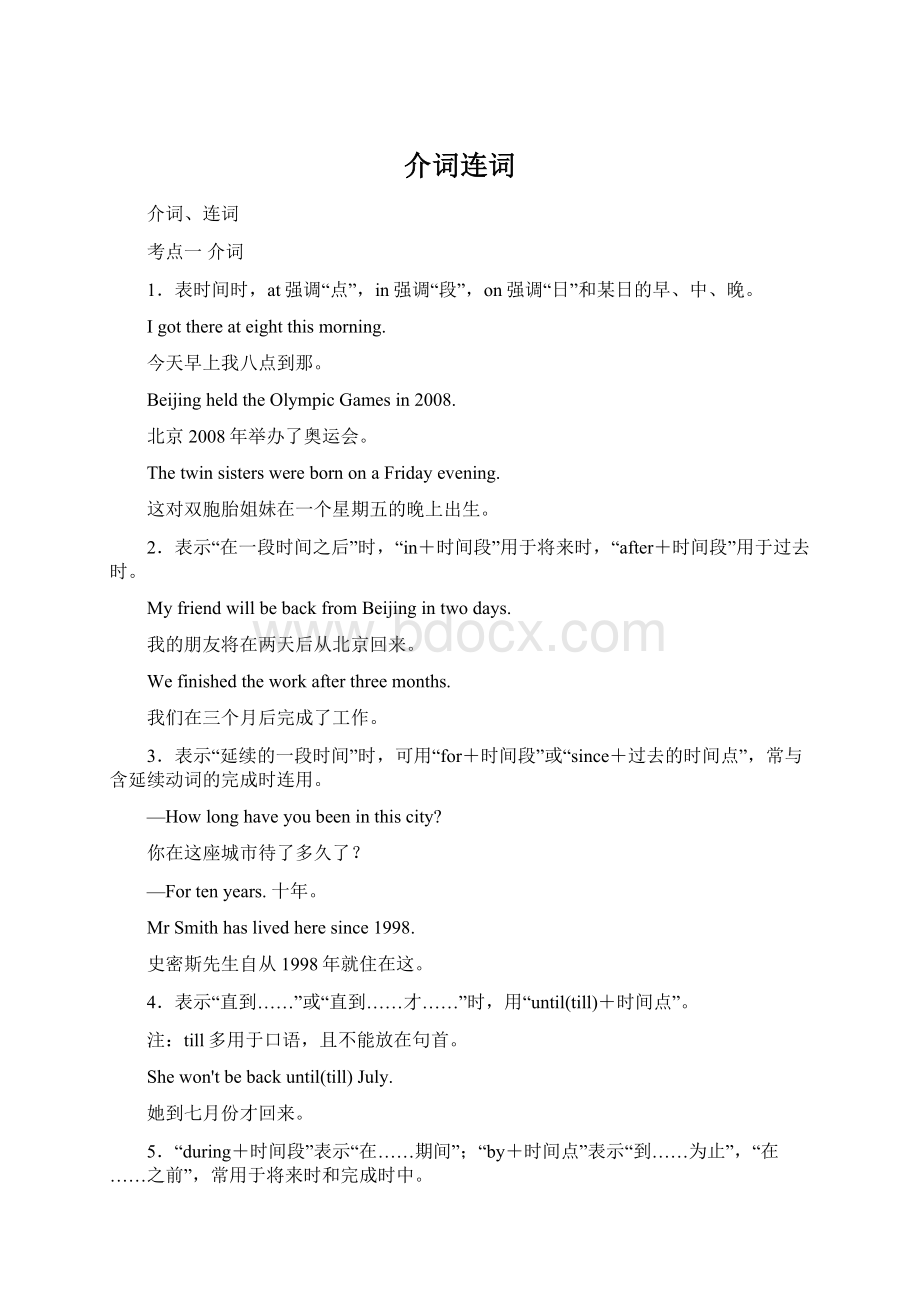介词连词.docx
《介词连词.docx》由会员分享,可在线阅读,更多相关《介词连词.docx(15页珍藏版)》请在冰豆网上搜索。

介词连词
介词、连词
考点一介词
1.表时间时,at强调“点”,in强调“段”,on强调“日”和某日的早、中、晚。
Igotthereateightthismorning.
今天早上我八点到那。
BeijingheldtheOlympicGamesin2008.
北京2008年举办了奥运会。
ThetwinsisterswerebornonaFridayevening.
这对双胞胎姐妹在一个星期五的晚上出生。
2.表示“在一段时间之后”时,“in+时间段”用于将来时,“after+时间段”用于过去时。
MyfriendwillbebackfromBeijingintwodays.
我的朋友将在两天后从北京回来。
Wefinishedtheworkafterthreemonths.
我们在三个月后完成了工作。
3.表示“延续的一段时间”时,可用“for+时间段”或“since+过去的时间点”,常与含延续动词的完成时连用。
—Howlonghaveyoubeeninthiscity?
你在这座城市待了多久了?
—Fortenyears.十年。
MrSmithhaslivedheresince1998.
史密斯先生自从1998年就住在这。
4.表示“直到……”或“直到……才……”时,用“until(till)+时间点”。
注:
till多用于口语,且不能放在句首。
Shewon'tbebackuntil(till)July.
她到七月份才回来。
5.“during+时间段”表示“在……期间”;“by+时间点”表示“到……为止”,“在……之前”,常用于将来时和完成时中。
Theytaughtthereduring2005~2008.他们在2005年至2008年期间在那教书。
Theteacherhadalreadystartedteachingbythetimeshegottoclass.
当她到班级的时候老师已经开始讲课了。
6.表地点时,in表示“范围较大的地方”,强调“空间”;at表示在“范围较小的地方”,强调“点”。
IliveinChina.我居住在中国。
Weoftenwaitforthebusatthebusstop.我们通常在公共汽车站等车。
7.表位置时,in表示“在……内”,on表示“在……上”(接触表面),on还可以表示“在两边”“在左/右边”。
Theyareputtingupapictureonthewall.他们正在往墙上张贴画。
Thegirlontherightisafamousactress.右边的女孩是一个著名的演员。
8.over表示在与某物不接触的“正上方”,under与其相对,表示“正下方”。
Theskyisoverourheads.天空在我们头顶上。
Thecatisunderthetable.那只猫在桌子底下。
9.above表示“在……的上方”,“高于”;below与其相对,表示“在……的下面”,“低于”。
Thetemperaturewillstayabovezerointhedaytime,butatnightitwillfallbelowzeroagain.
白天气温将保持在零度以上,但在晚上又将降到零度以下。
10.“across+表面”表示“横过”;“through+空间”表示“穿过”、“贯穿”;over表示从上面“越过”。
TheChangjiangRiveristoowideforsoyoungaboytoswimacross.
长江太宽了,这么小的孩子游不过去。
Theplaneflewoverthehighmountains.飞机飞越了群山。
Thesunshinegotintotheroomthroughtheglass.阳光透过玻璃进入房间。
11.behind表示“在……的后面”,其反义词组“infrontof”表示“在……的前面”,注意与inthefrontof的区别。
Wemustkeepourhandsbehindourbacks.我们必须一直把手放在背后。
Iwaswalkingdownthestreetwhenafriendofminestoodinfrontofme.
当一个朋友站在我面前时,我正沿着街道散步。
12.at/inthefrontof表示“在……里面的前部”,atthebackof表示“在……里面的后部”,inthemiddleof表示“在……的中部”。
XiaoMingsitsat/inthefrontoftheclassroom.小明坐在教室前面。
Thetwinsisterssitatthebackoftheclassroom.那对双胞胎姐妹坐在教室后面。
Theteacherisstandinginthemiddleoftheclassroom.老师在教室中间站着。
13.between表示“在两者之间”,包括两个以上的人或物中任何两者之间;among表示“三者或三者以上的人或物中间”。
Whenwetalkabouttheuniverse,wemeantheearth,thesun,themoon,thestarsandthespacebetweenthem.
我们谈论宇宙时,指的是地球、太阳、月球和星星以及它们之间的空间。
Somesupermarketsopenbetween8:
30a.m.and8:
00p.m..
一些超市在早上8:
30到下午8:
00之间营业。
Dothestudentsknowthedifferencesamongthefourwords?
学生们知道这四个单词之间的区别吗?
14.在与方位名词east,west,south,north连用时,in表示“在内部”,to表示“在外部”,on强调“接壤”。
HunanliesonthesouthofHubei.湖南在湖北的南面。
TaiwanliesintheeastofChina.台湾在中国的东部。
ChinaliestothewestofAmerica.中国在美国的西部。
15.表示“在……上”时,不是都用“on”,有时须用in。
在树上:
inthetree用于指树上的鸟,人等;onthetree用于指生长在树上的叶子,果实等。
在墙上:
inthewall镶嵌在墙内,如窗户,钉子,门;onthewall在墙的表面上,如地图,挂画等
在报纸上:
inthenewspaper指报纸上的内容;onthenewspaper用于指放于报纸上的东西,如眼镜
16.onthewayto在去-----的路途中
bytheway顺便说一下
Theymeteachotherontheirwayhome/toschool.他们在回家(去学校)的路上相遇了。
Bytheway,wholostthemoney?
顺便问一下,谁丢了钱?
17.表“用”时“with+工具、手段”,“by+交通工具(单数)”,“in+语言、嗓音”。
Asamiddleschoolstudent,don'twritewithapencil.
作为一个中学生,不要用铅笔写字。
Healwaysgoestoschoolbybus.他总是坐公共汽车去学校。
HetoldussomethinginterestinginJapanese.他用日语告诉了我们一些有趣的事情。
18.bemadeof+从成品上看得出原材料
bemadefrom+从成品上看不出原材料
bemadein+产地 bemadeby+制造者
ItissaidthatthiskindofclothismadeofsilkanditismadeinChina.
据说这种布料是由丝绸制成的并且由中国制造。
Thiswineismadefromgrapes.这酒是葡萄酿的。
ThismachineismadebyUncleWang.这台机器是王伯伯制造的。
19.介词和动词的固定搭配。
(1)同一动词和不同介词的搭配:
lookat(看) lookfor(找)
lookafter(照顾)lookover(检查)
lookoutof(朝……外面看)
look(a)round(环视)
arrivein+大地方(到达)
arriveat+小地方(到达)
hearof(听说)
hearfrom(收到……的来信)
spend+钱+onsth.(花钱做某事)
spend+时间+(in)doingsth.(花时间做某事)
(2)同一介词和不同动词的搭配:
askfor(要求) leavefor(动身去)
sendfor(派人去请) payfor(付钱)
waitfor(等待)
agreewithsb.(同意某人)
beginwith(以……开始)
helpwith(在……方面帮助)
catchupwith(赶上)
geton/alongwith(与……相处)
makefriendswith(与……交朋友)
(3)其他的介词和动词的搭配:
listento(听) comefrom(来自……)
falloff(从……上摔下) tryout(试验)
knockat/on(敲)
prefer...to...(比起……来还是……好)
learnbyoneself(自学)
takecareof(照顾)
stop...(from)doing(阻止……做……)
helponeselfto+食物(随便吃……)
getto(到达)
thanksto(多亏,由于)
20.介词和形容词的常见搭配:
begoodat(在……方面好)
beweakin(在……方面差)
begoodfor(对……有好处)
bebadfor(对……有坏处)
belatefor(迟到)
besorryfor(为……遗憾,抱歉)
befullof(充满)
bebusywith(忙于)
beangrywithsb.(对某人生气)
beafraidof(害怕)
beinterestedin(对……感兴趣)
bedifferentfrom(与……不同)
bestrictwithsb.(对某人严格)
bestrictinsth.(对某事严格)
befondof(喜爱)
21.beusedfor(=beusedtodosth.)意为“被用来做……”。
介词for表示用途,后接名词或动词ing形式。
beusedby意为“被……使用”,介词by后面接动作的执行者。
beusedas意为“被用作……”,介词as表示“作为”,beusedtodoingsth.意为“习惯于做……”,to是介词。
Thestampisusedforsendingletters.邮票是用来邮信的。
Englishiswidelyusedbytravellersandbusinesspeopleallovertheworld.
英语被全世界的旅行者和商人广泛使用。
Englishisusedasthesecondlanguageinmanycountries.
英语在许多国家被当做第二语言使用。
Iamusedtogettingupearlyeverymorning.我习惯早晨早起。
考点二连词
(一)并列连词
并列连词用来连接平行的词、词组或从句。
常见的并列连词有and,but,or,for,so,both...and...,either...or...,neither...nor,notonly...butalso...等。
1.表示平行或对等关系
and和both...and...两者都……
neither...nor...既不……也不……
notonly...but(also)...不但……而且……
when就在这时,突然……
Holdontoyourdream,andonedayitmayjustcometrue.
坚持你的梦想,总有一天它会实现。
YesterdayeveningIwasplayingthepianowhenthedoorbellrang.
昨天晚上,当门铃响的时候我正在弹钢琴。
2.表示转折关系
but但是 yet然而 while然而
while常用来表示前后鲜明的对比
It'sabeautifulplace,butthereweresomanypeopletherethatIcouldn'tfindaproperplacetotakephotos.
它是一个漂亮的地方,但是有太多的人以至于我不能找到合适的位置拍照。
3.表示选择关系
or或者;否则 orelse否则
not...but...不是……而是……
either...or...或者……或者……
在并列的否定句中,用or代替and构成完全否定,如果所连接的两部分都有否定词,用and而不用or连接。
WhenyouarelearningEnglish,useit,oryouwillloseit.
当你学英语的时候,要用它,否则你就会丢了它。
Theshoesdon'tfitme.They'reeitherbigorsmall.
这些鞋不适合我,它们不是大就是小。
4.表示因果推理关系
for因为,此时它引导的从句只能位于句尾,前面用逗号隔开。
(二)从属连词
1.引导名词性从句的主要有that(无词义,可省略),if和whether,whether可与ornot连用,它们在句中不作成分,在ask,wonder,notknow,wanttoknow,notbesure等后常用whether或if从句,而不用that从句。
TheforeigneraskedmeifIcouldspeakEnglish.
那个外国人问我是否会讲英语。
2.引导时间状语从句的主要有when,while,as,after,before,until/till,since,assoonas等。
Iarrivedattheairportaftertheplanehadtakenoff.飞机起飞后我到达了飞机场。
3.引导原因状语从句的主要有because,since,as等。
Moreandmorekidsbecomeunhappybecausetheyhavetoomanyactivitiestodo.
越来越多的孩子变得不开心,因为他们有太多活动要参加。
4.引导条件状语从句的主要有if,unless,once等。
当从句中需用一般将来时的时候,总是用一般现在时表将来。
Thesportsmeetingwillcontinueunlessitrainsthisafternoon.除非下午下雨,否则运动会会继续。
5.引导目的状语从句的主要有sothat,inorderthat等。
6.引导让步状语从句的主要有evenif,eventhough,(although)though等。
but和(although)though不能同时出现在一个句子中。
although比though更正式。
Thestoryishardtounderstandthoughtherearenonewwordsinit.
尽管里面没有生词,这篇短文还是很难理解。
7.引导地点状语从句的主要有where等。
8.引导比较状语从句的主要有than,as等,在as(so)...as中,后一个as是连词,引导比较状语从句。
Doyouthinkthatartisasinterestingasmusic?
你认为美术和音乐一样有趣吗?
9.引导方式状语从句的主要有as,asif,asthough等。
10.引导结果状语从句的主要有so,sothat,so...that...,such...that...等。
Themountainwassosteepthatfewpeopleinourcityreachedthetop.
这座山如此陡峭以至于我们市很少有人能爬到顶峰。
(三)易混连词
1.when,while,as
三者均可译为“在……时候”。
when引导的从句,动词既可以是延续性的,也可以是终止性的。
一般来说,当主句的动作正在进行时,when引导的从句的动作才发生;while引导的从句中,动词只能是
延续性的,一般来说,当while引导的从句的动作正在进行时,主句的动作才发生;as表示随着短暂动作的发生,另一行为伴随发生。
Hewasridingtoschoolwhenhewashitbyacarthismorning.
当他被一辆小汽车撞到的时候他正骑车去上学。
You'dbetterturnoffthewaterwhileyoubrushyourteeth.当你刷牙的时候你最好关掉水。
Shesangasshewalked.她一边走一边唱歌。
2.so...that...,such...that...
so+形容词+a/an+可数名词的单数+that从句;
so+many/much/few/little+名词+that从句;
such+a/an+形容词+可数名词单数+that从句;
such+形容词+不可数名词/可数名词复数+that从句。
Hangzhouissobeautifulacitythatlotsofvisitorscomehereeveryyear.
杭州如此美以至于每年都有许多游客来这里。
Sheissuchagoodgirlthatwealllikeher.
她是如此好的一个女孩,以至于我们大家都喜欢她。
Therearesomanystudentsontheplayground.操场上有如此多的学生。
考点训练
1.(2011·临沂)Ifyousitinachair________alongtime,yourbackmaybegintohurt.
A.atB.inC.onD.for
2.(2011·台州)ShanghaiDisneylandhasstartedtobebuiltanditwillbeopen________fiveyears.
A.inB.forC.fromD.before
5.(2011·芜湖)—Look!
Therearesomanypeopleinthepark.
—Nobodylikestostayathome________Sundaymorning.
A.inB.onC.atD.to
6.(2011·河北)Thisschoolisdifferent________others.Ithasmanyoutofclassactivities.
A.offB.fromC.ofD.for
8.(2011·烟台)—Canaplanefly________theAtlanticOcean?
—Yes,butitneedstogo________thecloudsforhours.
A.across;throughB.through;acrossC.across;acrossD.through;through
9.(2011·安徽)Whataniceday!
Weshouldgosightseeing________watchingTVinthehotel.
A.becauseofB.insteadofC.togetherwithD.outof
11.(2011·河南)—MrHu,canyoutellushowtolearnmathwell?
—Sure.Butremembernothingcanbelearned________hardwork.
A.byB.atC.withoutD.for
12.(2011·黄冈)—Yourcoatlooksverynice.What'sitmade________?
—Cotton,anditismade________Wuhan.
A.from;inB.of;inC.from;onD.of;on
13.(2011·扬州)It'sveryfriendly________himtohelpmewhenI'mintrouble.
A.forB.toC.ofD.with
14.(2011·扬州)Hehadtoretire(退休)early________poorhealth.
A.asaresultB.becauseC.soD.becauseof
15.(2011·广东)It'stime________theweatherreport.Turnontheradio,please.
A.toB.inC.atD.for
16.(2011·福州)—________Mary________Alicehasjoinedthemusicclubbecausetheyhavenotime.—It'sapity!
A.Both;andB.Either;orC.Neither;nor
17.(2011·临沂)Don'tforgettowashyourhands________youhavemeals.
A.beforeB.untilC.thoughD.unless
18.(2011·江西)Comeon,________you'llbelate.
A.andB.butC.orD.so
19.(2011·苏州)Goodtoseeyouagain.It'salmostthreeyears________wemetlastti